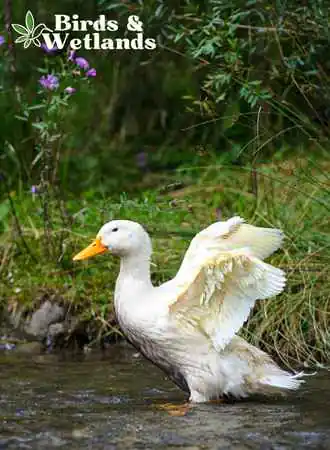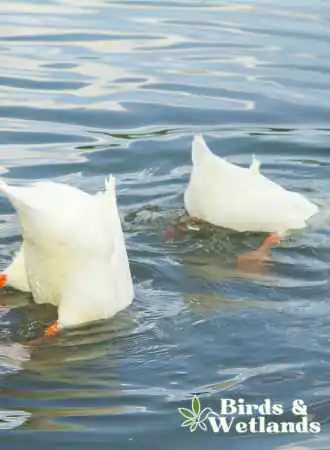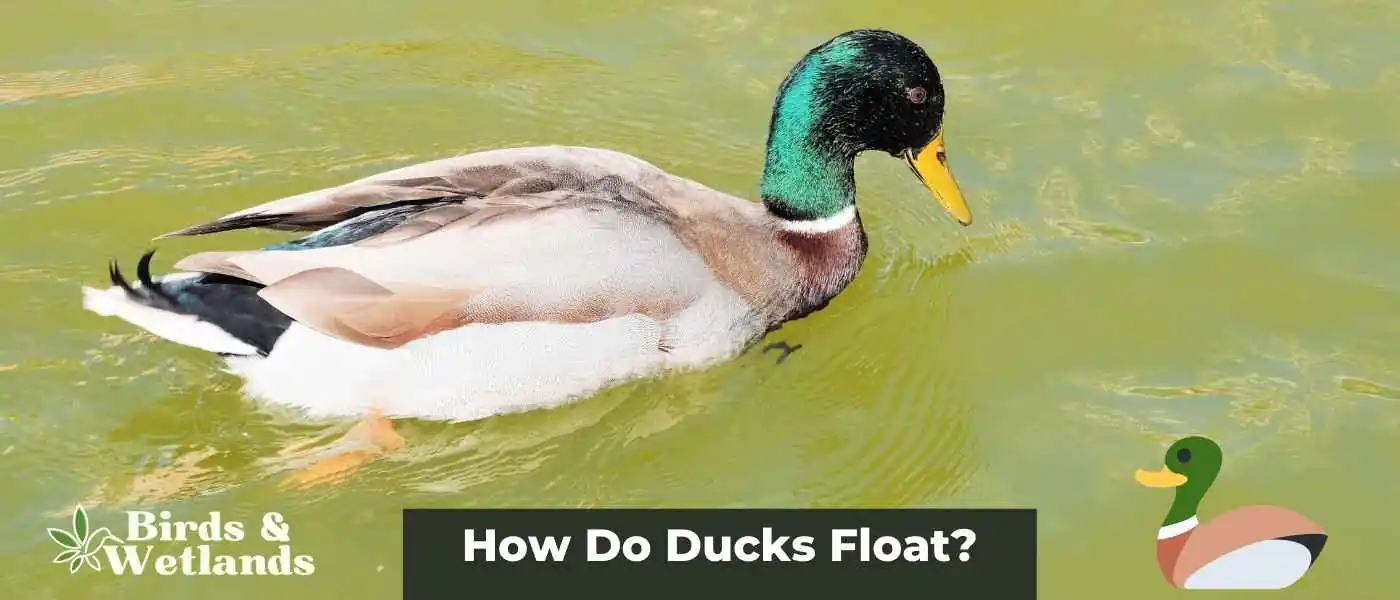Many people have seen ducks, whether they’re swimming in a pond or waddling around a park.
But how do ducks stay afloat?
Ducks float due to their buoyant bodies and waterproof feathers. Their bodies are filled with lightweight, insulating feathers, and their bones are hollow, making them less dense than water. Furthermore, ducks have a gland near their tail that produces oil. They distribute this oil over their feathers during preening, making them waterproof. This helps them stay dry and warm, and also adds to their buoyancy, enabling them to float effortlessly on water.
Key Takeaways on How Do Ducks Float
- Ducks have a special gland called the uropygial gland or preen gland, located at the base of their tail, which produces an oil that they spread over their bodies to make their feathers water-repellent. This prevents their feathers from getting saturated and helps them weigh less in water.
- Duck feathers possess a tightly interlocked system of barbs that trap air, which helps the birds float, the trapping air being vital. When ducks need to dive underwater, they can squeeze the air out by pressing their feathers, and trap air again after resurfacing and shaking off.
- Ducks have internal air sacs, including their lungs, along the length of their central body, which they keep filled with air to stay buoyant. They can release the air from these sacs when they want to dive underwater. This system functions like miniature helium balloons inside their bodies.
- Like many other bird species, ducks have hollow bones. These bones are strong yet incredibly light, which not only allows them to fly but also helps them float.
- Many other bird species share several characteristics with ducks, such as the waterproofing gland and hollow bones, and should theoretically be able to float as well. Approximately 90% of birds can float for at least two weeks if they die at sea. However, ducks are clearly more adept at floating, with 100% of them managing to float for much longer spans of time.
Do Ducks Actually Float?

Yes, ducks float. Their ability to stay buoyant results from thousands of years of evolution. Evolution is how organisms adapt to their changing environments over time. And in the case of ducks, they need the ability to float to search for food, escape from predators and attract a mate.
When ducks float, they do not have to expend much energy compared to swimming. They still use their webbed feet to paddle and propel their bodies around.
How Does A Duck Float?
Buoyancy can be defined as an object’s tendency to float or sink in a given medium. Things denser than their surrounding medium tend to sink, while those less dense tend to float.
Ducks are known for having a buoyant body composition. These waterfowl have hollow bones and a high percentage of body fat and oils, which are lighter than water and help to reduce their overall density.
| Key Characteristics | Function | Additional Details |
|---|---|---|
| Uropygial Gland | Provides oil for waterproofing | This gland is located at the base of a duck’s tail and produces oil that ducks spread over their bodies, making their feathers water-repellent. |
| Feather Structure | Traps air to aid buoyancy | Duck feathers have a tightly interlocked system of barbs that trap air, helping them float. Ducks can squeeze the air out to dive underwater. |
| Internal Air Sacs | Store air for buoyancy | Ducks have a system of internal air sacs, including their lungs, along their central body. They keep these sacs filled with air for buoyancy and can release the air when they want to dive. |
| Hollow Bones | Reduces weight to aid buoyancy and flight | Ducks, like many other birds, have hollow bones that are strong yet incredibly light. This lightness allows them to float and fly with ease. |
Feather Coatings
A special feather coating enables ducks to float on water. The waxy coatings on duck feathers repel cold water, reducing overall weight and allowing the ducks to float easily.
Furthermore, the waterproof feathers’ complex structure and arrangement create a large air pocket between each plume, allowing air to flow freely and keeping the ducks buoyant.
A duck’s feathers remain water-resistant thanks to the special oily substance the uropygial gland (preen gland) or oil gland secretes. This gland is found in the duck’s tail. This oily substance, known as preen oil, makes feathers waterproof. As the oil coats the feathers, it lowers surface tension and allowing them to repel water. Without the preen oily, their feathers will absorb water.
Ducklings can’t produce their own preen oil yet. So, the mother duck secretes the oil and lets the ducklings swim into it, effectively waterproofing their down feathers.
Interlocking Feathers

Ducks can trap air between their own feathers and bodies to keep afloat on the water’s surface. These feathers have tiny barbs that allow them to latch together like Velcro, forming an air pocket between the feathers and the skin. Ducks can then release trapped air bubbles at will. The air bubbles add to the duck’s buoyancy.
Interestingly, these unique feather structure also traps warm air close to the skin, creating an insulation layer. This layer keeps the duck’s skin dry and helps reduce heat loss through the feathers.
A duck’s body floats more easily than other animals because of the air bubbles. It also has complete control over these air bubbles, allowing it to release or trap air as needed to dive beneath or above the water’s surface.
Ducks can easily maneuver across the surface of any body of water, giving them time and space to hunt or flee from predators while remaining warm and dry at all times.
Hollow Bones and Air Sac
Ducks have hollow bones. These bones are specially designed to help the ducks swim and float. Their hollow avian bones are light weight, allowing them to stay afloat with less effort.
Furthermore, the finely woven interior of their bones provides them with increased structural support without weighing them down.
Ducks are well-suited for floating on water’s surface due to their lightweight construction and reinforced structure. Their bones aren’t literally hollow like a drinking straw but filled with woven bone material without adding much weight.
Extremely Buoyant Bodies
A duck’s natural buoyancy helps it float. Some ducks can dive deep into the water without ever sinking below the surface, which is even more impressive.
At the center of their buoyant bodies is an adaptation unique to ducks, the air sacs. These internal structures help ducks achieve a balloon-like effect on water. They also help respiration by transporting oxygen directly into their bloodstreams and storing air in balloons, filling their feathers and other body cavities when submerged.
They also have additional air pockets throughout their bodies. These distinctive physical features give ducks advantages when it comes to floating on the water’s surface, making them one of nature’s best swimmers.
Do Ducks Get Wet in Water?

No, ducks remain dry even after swimming or floating on the water’s surface. Their waterproof feathers allow them to paddle and dive underwater, almost completely dry.
Not only that, but the water resistance of their plumage acts as a wind and cold temperature shield, allowing them to stay warm even when staying afloat in frigid waters.
So, how do ducks keep their feathers dry while swimming? The secret is in their distinct preen oil or hydrophobic substance. This water-repellent coats each feather, repelling water and moisture. The duck spreads this oily substance the preen gland produces over its entire body and it is called “preening”.
As a result, most ducks have evolved a remarkable waterproof outer layer that allows them to move in even the most difficult aquatic environments. This high level of performance gives them an advantage in everything from food hunting to evading predators such as raccoons and hawks.
Do Ducks Sink?

Ducks can’t sink because they have buoyant bodies, internal air sacs that store air like balloons and waterproof feathers. These anatomical features allow them to float and, in the case of diving ducks, not completely sink while diving underwater.
How Long Can Ducks Float?
When it comes to floating, ducks are natural experts compared to other birds. They have streamlined bodies that allow them to glide effortlessly across the water’s surface without sinking. Their webbed feet form a super strong paddle that they can use to propel themselves forward at incredible speeds. Treading water requires much more effort than floating, so ducks don’t tread water.
Furthermore, ducks are able to float for long periods because their feathers act as a waterproof insulators and keep them warm in cold temperatures.


